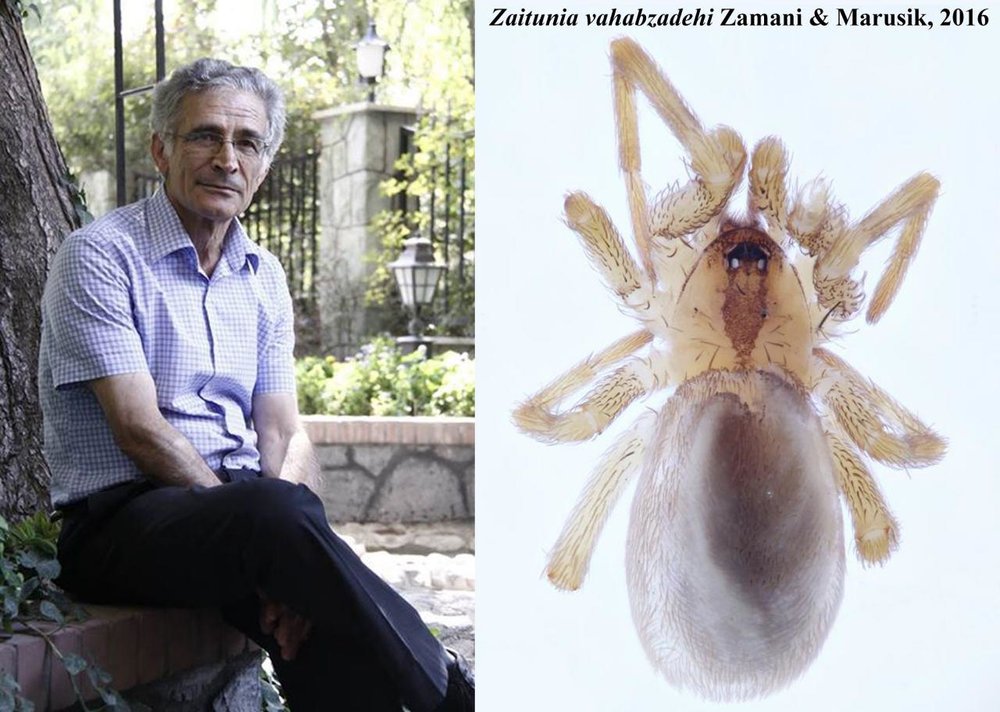Zaitunia vahabzadehi, a real Persian tale

Each known species on the Earth has a specific name which is called the “scientific name” of that species. Scientific names normally have two parts and in some cases, three. These names are considered as common points which allow scientists or even public throughout the world to talk precisely about their determined species of plants or animals.
Zaitunia vahabzadehi is a recently discovered species of the genus Zaitunia from Iran that was described by Alireza Zamani, a young M.Sc. student of Animal Biosystematics from University of Tehran and Dr. Yuri M. Marusik from Institute for Biological Problems of the North RAS, Magadan, Russia. As in all scientific names, this one is also made up of a “generic name” or “generic epithet” which is Zaitunia, and “specific name” or “specific epithet”, which is vahabzadehi.
International rules have prohibited the usage of one name for more than once; though this does sometimes happen. Scientific naming is a much formalized process and there are many rules that must be followed. One would have to follow the rules of the International Code of Zoological Nomenclature (http://iczn.org).
Why the scientific name of a species would change?
There are only a few reasons for scientists to change the scientific name of a species. The most importants are: sometimes, it is discovered that a species was identified with a different name earlier in time than the name that is commonly in use. In such cases, they revert it to the earlier name. In other cases, it is discovered that the genetics of a subspecies or species is sufficiently different that a new or different subspecies is identified. In such cases, the original group would normally retain the original name and the newly discovered group would become the new subspecies or species. The other reason for a change in the name might be a mistake of some sort, but this is rather uncommon.
The change of the scientific names is because scientists understand more about their relationships with other species. For example, Arctic fox were called Alopex lagopus for many decades and recently have been moved to the genus Vulpes with the current nameVulpes lagopus. This was done because it was discovered that the Arctic fox was more closely related to the red fox (Vulpes vulpes). The change of a scientific can happen and actually is happening a lot these days, especially because a lot of new insights about species are being revealed through the genetics.
Unique because of science
But scientific naming routinely is unique. For example, if Zaitunia, a genus of spiders in the family Filistatidae, has a species whose name is Zaitunia vahabzadehi, no other animal species can be given the same name. So, if you are a Persian scientist studying relatives of Zaitunia and you want to discuss about it with a Finnish researcher, you both use the scientific name and know exactly what the other one is talking about.
Filistatidae are well known in our country because of many taxonomical surveys that have been carried out by scientists such as Paolo Brignoli, Alireza Zamani, Omid Mirshamsi and Yuri M. Marusik.
Another species Zaitunia akhanii was also described last year by this team (Marusik and Zamani). As you can see, Zaitunia vahabzadehi and Zaitunia akhanii both share the same generic epithet and this indicates that they are all thought to be more closely related to each other than to any other non-Zaitunia species of Filistatidae.
Both specific epithets adopted by the scientific team in the honor of two persons who had great effects on the Environment Field in Iran.
Iranian ecologist, Hossein Vahabzadeh is admired by his colleagues and students for many reasons: He has taught ecology and environmental science more than 40 years in various universities of Iran, and has many magnificent books in his field too. Vahabzadeh has also established the first generation of “Nature Schools” in Iran as a primary practical learning and creativity school.
The other species, Zaitunia akhanii, was appointed to Dr. Hossein Akhani, Associate Professor at the Department of Botany, University of Tehran. Akhani is a pioneer Iranian scientist who is hoping to revitalize the Lake Urmia, once one of the world’s largest brine shrimp habitats and now considered as a water body which is trapped in the extinction vortex. Akhani, as a biologist and conservationist has published many books and articles and also has collected a total number of ca. 18000 specimens from most parts of Iran and some countries in SW Asia and Europe. Many environmentalists admired him because of his tireless efforts for natural environments of Iran.
Leave a Comment